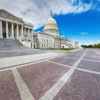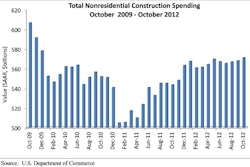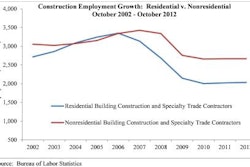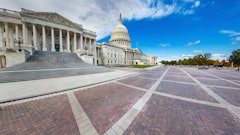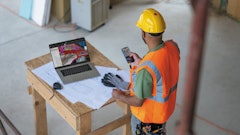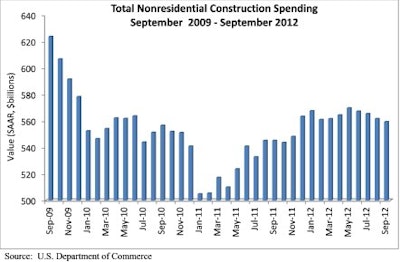
Despite a flurry of activity in residential construction spending, nonresidential construction spending decreased 0.4 percent in September, with outlays falling to a seasonally adjusted annual rate of $559.4 billion, according to the November 1 construction spending report by the U.S. Commerce Department. Year-over-year, total nonresidential construction spending is up 2.6 percent, slightly higher than inflation.
Private nonresidential construction spending slipped 0.1 percent for the month but remains 8.8 percent higher than the same time last year. Public nonresidential construction spending decreased 0.8 percent for the month and is 3.6 percent lower than one year ago.
Nonresidential construction subsectors posting the largest decreases in spending for the month include:
- religious, down 6.1 percent
- health care, down 4.9 percent
- commercial, down 4.5 percent
- lodging, down 2.7 percent
- office, down 2.1 percent
Construction subsectors that experienced decreases in spending year-over-year include:
- religious, down 16.8 percent
- water supply, down 12.7 percent
- conservation and development, down 6.5 percent
- educational, down 3.2 percent
Six out of 16 nonresidential construction subsectors posted increases for the month, including:
- communication, up 6.4 percent
- manufacturing, up 3.5 percent
- amusement and recreation, up 2.8 percent
- conservation and development, up 2.8 percent
- transportation, up 2.4 percent
- power, up 1.3 percent
One-half of the nonresidential construction subsectors experienced increases in spending on a year-over-year basis including:
- lodging, up 25 percent
- power, up 19.2 percent
- transportation, up 11 percent
- office, up 2.4 percent
Residential construction spending jumped 2.7 percent for the month and 19.2 percent higher compared to the same time last year. Total construction spending, which encompasses nonresidential and residential spending, was up 0.6 percent for the month and 7.8 percent higher compared to September 2011.
“Concerns regarding the fiscal cliff, a slowing global economy and perhaps the November elections became more apparent in September’s construction spending data,” said Associated Builders and Contractors Chief Economist Anirban Basu. “A number of construction segments that were expanding in prior months retreated in September, including healthcare, commercial construction and office.
“It is likely that some members of the developer/owner community are putting their projects on hold in the hope that future months will bring in more policy and economic transparency and stability,” Basu said. “The implication is when various sources of uncertainty are addressed, including issues related to automatic sequestration, Europe and the Middle East, there will be a re-acceleration of nonresidential construction spending.
“Despite economic uncertainty, some construction segments are experiencing increased levels of spending, including manufacturing and power,” said Basu. “In stark contrast, projects closely associated with public sector capital budgets continue to fall.
“In prior months, there was a well-established pattern of private construction spending gains offset by public construction spending losses,” Basu said. “That pattern no longer exists as both private and public construction spending are in decline.
“It is suspected that October will be another month of hesitation among many economic decision-makers that will show lackluster nonresidential construction performance,” said Basu. “The forecast is for subdued construction in the months ahead, with more rapid recovery expected late next year.”
View the August 2012 Spending report.



